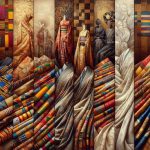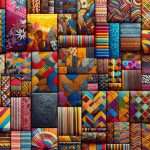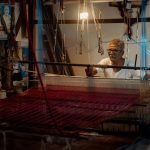When you consider traditional fabrics, you're stepping into a world where cultural heritage and craftsmanship intertwine seamlessly. Take Indonesian Ikat, for instance, with its intricate patterns, or Japanese Kimono Silk, known for its masterful dyeing methods. Indian Sari Weaves burst with vibrant colors, while African Kente Cloth carries deep historical significance. But what makes Peruvian Alpaca Textiles a symbol of wealth, and how do European Brocades blend tradition with modernity? As you explore these fabrics, you'll discover the artisans' dedication to preserving their heritage through their unique artistry. What stories do these fabrics hold?
Table of Contents
Key Takeaways
- Traditional fabrics often feature intricate patterns and vibrant colors, deeply rooted in cultural narratives and heritage.
- Each region's unique weaving and dyeing techniques reflect profound cultural significance and historical importance.
- Artisans frequently use sustainable, eco-friendly practices to preserve traditional methods while minimizing environmental impact.
- Symbols and motifs in the fabrics convey stories, social status, and cultural identities, passed down through generations.
- Modern adaptations merge age-old craftsmanship with contemporary tastes, ensuring the survival and relevance of traditional textiles.
Indonesian Ikat
Indonesian Ikat, a traditional dyeing technique, is renowned for its intricate patterns and vibrant colors. You're probably fascinated by how these stunning designs come to life.
Unlike other methods, Ikat involves dyeing the threads before weaving. This process requires immense skill and precision, as the threads must be carefully tied and dyed in specific sequences to achieve the desired patterns.
Mastering Ikat means understanding the traditional patterns that have been passed down through generations. Each region in Indonesia boasts its own distinct motifs, often inspired by nature, mythology, or daily life. The artisans' hands are the true magic behind these designs, ensuring that each piece is unique and tells its own story.
But it's not just about the patterns. The dyeing techniques used in Ikat are equally impressive. Artisans employ natural dyes derived from plants, minerals, and other organic materials. This not only gives the fabric its vibrant hues but also guarantees its longevity and cultural authenticity.
Japanese Kimono Silk
Among the world's most exquisite textiles, Japanese Kimono silk stands out for its elegance and intricate craftsmanship. When you delve into the rich history of this fabric, you'll find that each piece is a masterpiece, meticulously crafted using time-honored artistic techniques.
The kimono, a symbol of Japanese culture, embodies not just fashion but also storytelling through its intricate motifs and vibrant colors.
Contemporary adaptations have guaranteed that kimono silk remains relevant, blending traditional designs with modern aesthetics. This fusion keeps the cultural preservation alive while attracting a new generation of admirers.
Additionally, the artisans behind these garments are increasingly embracing sustainable practices, ensuring that the art of kimono-making doesn't harm the environment.
Consider these key aspects:
- Artistic techniques: Masterful dyeing and weaving methods that convey profound cultural narratives.
- Modern adaptations: Innovative designs that fuse the old with the new, making kimono silk versatile and trendy.
- Sustainable practices: Eco-friendly methods that honor traditional craftsmanship while minimizing environmental impact.
Indian Sari Weaves
Just as Japanese kimono silk captivates with its elegance, Indian sari weaves mesmerize with their diversity and vibrant patterns. When you explore Indian saris, you'll find that each region boasts its unique weaving techniques. From the intricate Banarasi silks of Varanasi to the lightweight, breathable cottons of Bengal's Tant saris, the variety is astounding.
Each weave carries deep cultural significance, often passed down through generations. The colors used in these saris aren't just for aesthetics; they embody rich color symbolism. For instance, red signifies auspiciousness and is commonly worn by brides, while white represents purity and is often reserved for spiritual ceremonies.
Regional variations also play a pivotal role in defining the identity of these fabrics. In the south, Kanchipuram saris are known for their rich, contrasting borders and intricate designs. Meanwhile, in the west, you'll encounter the Patola saris of Gujarat, distinguished by their double ikat weaving technique, which requires exceptional skill and precision.
Mastering the nuances of Indian sari weaves allows you to appreciate not just the fabric, but the profound cultural narratives woven into every thread. By understanding these elements, you deepen your connection to a tradition that's both timeless and continuously evolving.
African Kente Cloth
When you think of African Kente cloth, you should consider its rich historical significance and vibrant symbolic meanings.
This intricate fabric, originating from Ghana, isn't just a piece of cloth; it's a tapestry of stories and cultural heritage.
You'll find each color and pattern carries a specific message, reflecting the values and history of the people.
Historical Significance
Kente cloth, one of Africa's most iconic textiles, holds deep historical significance that dates back to the Ashanti Kingdom in Ghana. As you explore its origins, you'll uncover a rich tapestry of cultural importance and artistic techniques. The Ashanti people initially reserved Kente for royalty and special occasions, reflecting its esteemed status within the community. The intricate weaving methods employed in creating Kente are a tribute to the artisans' skill and dedication.
To fully appreciate the depth of Kente cloth's historical significance, consider:
- Origins: Kente's roots trace back to the 17th century, where it was first woven by Ashanti and Ewe weavers using silk and cotton.
- Cultural Importance: Worn by kings, queens, and important figures, Kente symbolized power, prestige, and cultural heritage.
- Artistic Techniques: Weavers use a complex process involving narrow strips of fabric, which are meticulously handwoven and then stitched together to form larger pieces.
Understanding Kente cloth's historical context allows you to grasp its enduring legacy. It's not just fabric; it's a living history and a symbol of identity that continues to resonate within and beyond Africa. By mastering these aspects, you gain a deeper appreciation for this extraordinary textile.
Symbolic Meanings
Beyond its historical significance, the Kente cloth's intricate patterns and vibrant colors are imbued with profound symbolic meanings that convey messages about the wearer's identity, status, and beliefs. Each Kente design tells a unique story, often reflecting the cultural significance of the Ashanti and Ewe peoples of Ghana. When you wear Kente, you're not just donning a piece of cloth; you're embracing a rich tapestry of history and tradition.
The patterns and colors of Kente are more than just artistic expression. For instance, the color gold symbolizes royalty, wealth, and spiritual purity, while blue represents peace and harmony. The specific arrangement of these colors and patterns can indicate the wearer's social status or commemorate significant events. You'll find that certain designs are reserved for special occasions, such as weddings or festivals, underscoring their deep-rooted cultural importance.
As you explore the world of Kente, you'll appreciate the meticulous craftsmanship that goes into each piece. Weavers employ age-old techniques, ensuring that every thread contributes to the fabric's narrative. By understanding these symbolic meanings, you gain a deeper appreciation for Kente's role in African cultural heritage.
Peruvian Alpaca Textiles
Peruvian alpaca textiles offer a rich tapestry of history, culture, and craftsmanship that you won't find anywhere else. The alpaca fiber properties, such as its softness, durability, and hypoallergenic nature, make it highly prized. Culturally, alpaca holds a special place in Andean communities, symbolizing wealth and status for centuries. Understanding these aspects deepens your appreciation for the textiles' significance.
Traditional weaving techniques, honed over generations, showcase intricate patterns and vibrant colors. These methods aren't just about creating fabric; they're cultural narratives woven into each piece. In today's world, artisans blend these age-old techniques with modern adaptations to meet contemporary tastes, ensuring the craft's survival and relevance.
By immersing yourself in Peruvian alpaca textiles, you gain insight into:
- Alpaca Fiber Properties: Discover how its unique qualities make it a luxury material.
- Cultural Significance: Learn about the deep-rooted traditions and meanings behind each textile.
- Traditional Weaving Techniques and Modern Adaptations: Appreciate the skill and innovation that keep this ancient craft alive.
Mastering the nuances of Peruvian alpaca textiles allows you to value not just the material, but the rich heritage and expert craftsmanship behind each creation.
European Brocades
You'll find European brocades offer a fascinating glimpse into history, originating from the Byzantine Empire and spreading through Italy and France.
As you explore these fabrics, you'll notice how design techniques have evolved, incorporating intricate patterns with metallic threads.
This evolution highlights the artistry and innovation of European textile artisans over centuries.
Historical Brocade Origins
Many believe that European brocades, known for their intricate patterns and luxurious feel, trace their origins back to the opulent courts of the Renaissance. During this period, brocades became a symbol of wealth and status, heavily influenced by Chinese silk weaving techniques brought over via the Silk Road. By the time they reached the hands of medieval royalty, these fabrics had already evolved to include complex designs and rich textures that were perfect for adorning the nobility.
When you explore the history of European brocades, consider the following:
- Cultural Exchange: The fusion of Eastern and Western techniques resulted in textiles that weren't only visually stunning but also a reflection of global interconnectedness.
- Symbol of Power: Brocades were often commissioned by royalty and the elite to display power, sophistication, and an appreciation for fine artistry.
- Artistic Expression: The detailed patterns and luxurious materials used in brocades allowed for artistic expression that was unmatched in other fabrics of the time.
Design Techniques Evolution
The evolution of design techniques in European brocades showcases a remarkable journey of innovation and artistic mastery. As you explore the intricate patterns and luxurious textures, you'll find that modern adaptations have seamlessly blended with age-old traditions. These adaptations often reflect diverse cultural influences, enriching the brocades with a unique fusion of styles.
The introduction of new motifs and color schemes from various cultures has breathed new life into this historic fabric, making it more relevant and appealing in today's global market.
Technological advancements have played a pivotal role in this transformation. The use of computerized looms and digital design tools has revolutionized brocade production, allowing for greater precision and complexity in patterns. This leap forward not only enhances the aesthetic appeal but also increases efficiency, making high-quality brocades more accessible.
Sustainability efforts are also reshaping the brocade industry. Eco-friendly dyes and organic fibers are now being used to create brocades that aren't only beautiful but also environmentally responsible. By incorporating sustainable practices, you can contribute to preserving the planet while enjoying the timeless elegance of European brocades.
This blend of tradition and innovation guarantees that brocades remain a cherished fabric for generations to come.
Middle Eastern Embroidery
Middle Eastern embroidery showcases intricate designs and vibrant colors that reflect the region's rich cultural heritage. You'll find colorful stitching and traditional patterns that speak volumes about the area's history and artistry. The cultural significance of these intricate designs can't be overstated; each motif and color choice tells a story, often passed down through generations.
When you explore Middle Eastern embroidery, you'll notice:
- Symbolism: Patterns often carry deep meanings, depicting elements of nature, spirituality, and daily life.
- Techniques: Methods like cross-stitch, couching, and mirror work are employed to create these mesmerizing pieces.
- Materials: Artisans use silk, cotton, and metallic threads to enhance the texture and visual appeal of the fabric.
You can appreciate the dedication that goes into every piece, as artisans spend countless hours perfecting their craft. This embroidery isn't just about decoration; it's a form of storytelling and cultural preservation. By mastering these techniques, you're not just creating beautiful fabrics—you're keeping a valuable cultural tradition alive.
Immerse yourself in Middle Eastern embroidery, and you'll open up a world of history, artistry, and cultural depth that continues to inspire and captivate.
Frequently Asked Questions
What Are the Main Differences Between Synthetic and Natural Fabrics?
You'll find that natural vs synthetic fabrics differ mainly in origin and properties. Natural fibers offer comfort and breathability, while synthetics provide durability and cost-efficiency. Each has benefits and drawbacks depending on your needs.
How Do You Care for and Clean Traditional Fabrics?
You absolutely have to master cleaning methods and storage tips for traditional fabrics, or they'll disintegrate before your eyes! Hand wash with mild detergent, air dry flat, and store in a cool, dark place for longevity.
What Impact Does Fabric Production Have on the Environment?
Fabric production impacts the environment through resource usage and pollution. Prioritize environmental sustainability by choosing fabrics from ethical sourcing practices. You can reduce your carbon footprint and support responsible industry standards by making informed decisions.
Are Traditional Fabrics Used in Modern Fashion Design?
You'll find traditional fabrics increasingly used in modern fashion design. They offer unique aesthetics and embody sustainability. By blending traditional techniques with innovation, designers create clothing that's both stylish and environmentally conscious.
How Can You Identify Authentic Traditional Fabrics From Imitations?
To identify authentic traditional fabrics, examine the weave and patterns closely. Authenticity often shows in craftsmanship and material quality. Check for labels, research the origins, and consult experts to verify you're getting genuine traditional fabrics.
- Does Chiffon Fabric Stink - July 15, 2025
- Does Chiffon Fabric Affect the Economy - July 15, 2025
- Does Cotton Fabric Have a Nap - July 15, 2025







